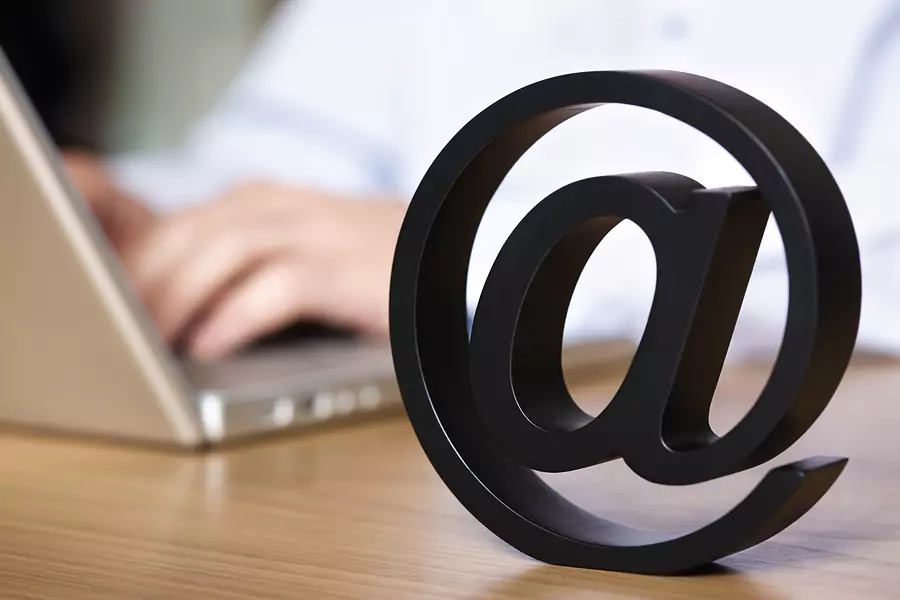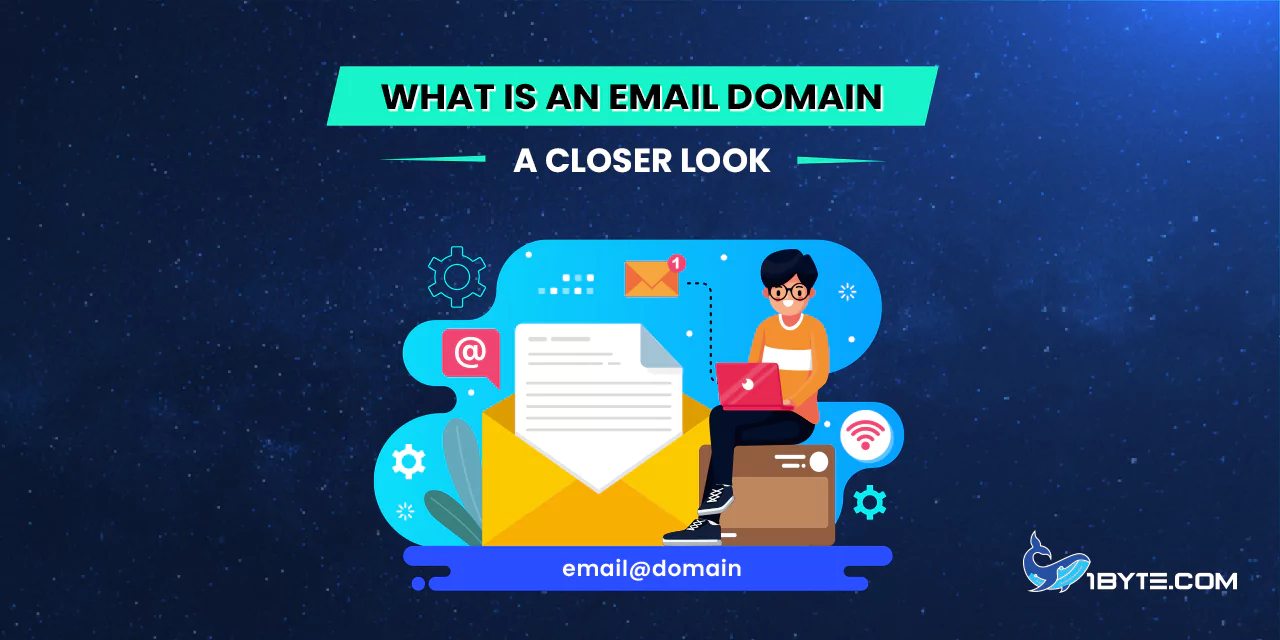What is an email domain? Understanding email domains is fundamental in today’s digital communication landscape. In this article, we’ll take a closer look at the concept of email domains, unraveling their significance and how they function. Whether you’re a seasoned email user or new to the world of online communication, grasping the essence of email domains is a crucial step toward effective and secure email communication. Let’s dive into the world of email domains and demystify this essential aspect of modern messaging.
What is an Email Domain?
In this first section, the aim is to provide a comprehensive yet easily digestible answer to the question “what is an email domain?. By adopting a clear and concise approach, readers will gain a firm grasp of email domains and their role in modern messaging. So, let’s embark on this exploration to enhance our comprehension of this essential facet of online communication.
Definition of an email domain
An email domain, in its simplest form, is the part of an email address that comes after the “@” symbol. It signifies the unique location or destination where an email message should be delivered within the vast network of the internet. Essentially, it’s the online equivalent of a physical address, specifying where an email should be sent.

The domain portion of an email address serves as an identifier, directing the message to the correct recipient’s inbox. It is often associated with an organization, service provider, or entity that manages the email infrastructure. For example, in the email address “[email protected],” the domain is “example.com.”
Understanding email domains is key to comprehending what an email domain is. They play a pivotal role in ensuring messages reach their intended destinations accurately and efficiently. As you explore the intricacies of email domains further, you’ll discover their broader implications in the realm of online messaging and communication.
Recommended reading: How to Set Up a Gmail Custom Domain: A Step-by-Step Guide
Importance of email domains
The importance of email domains cannot be overstated, and here’s why:
- Credibility and Trust: A personalized email domain adds credibility to your messages. When recipients see an email from your domain, they’re more likely to trust it and open it, knowing it’s not a threat.
- Professionalism: Your email domain often reflects your organization’s name. This professionalism demonstrates that your business is legitimate and well-established, enhancing your reputation.
- Branding: Consistency is key in branding. Using your business domain in your email address reinforces your brand identity. It’s a mistake to have a great business domain name and then use a generic email address like Gmail or Outlook.
- Sales and Traffic: Trustworthy emails are more likely to be opened, making email marketing more effective. You can also drive traffic to your website by sharing valuable content through newsletters.
- Security: Personalized email domains can offer improved security. Generic email services are frequent targets for spammers and malware, but having your own domain provides greater control and protection over your online information.
Understanding the significance of email domains sheds light on how they impact your online presence, credibility, and security. As you navigate the world of email communication, harnessing the potential of your email domain becomes a strategic advantage for businesses and individuals alike.
How email domains work
Understand how email domains work goes a long way in answering the question “what is an email domain?”.
- Unique Identifier: An email domain is a unique identifier that comes after the “@” symbol in an email address. It distinguishes one email address from another.
- Email Routing: When you send an email, your email service provider uses the domain to route your message to the recipient’s email server. The recipient’s domain determines where the email should be delivered.
- DNS Records: Domains rely on Domain Name System (DNS) records to function. These records contain information about where email messages for that domain should be directed.
- Mail Servers: Email domains are associated with specific mail servers. These servers receive and store incoming emails until they are retrieved by the recipient.
- Recipient Verification: Before delivering an email, the recipient’s email server verifies if the domain exists and if the recipient’s email address is valid within that domain.
- Sending and Receiving: When you send an email, your email client or provider communicates with your domain’s mail server to initiate the sending process. The recipient’s email server receives the email from your domain’s server.
- Reply Address: When the recipient responds to your email, their email client uses your email domain to route the response back to your email server.
Recommended reading: How to Sell Your Domain Name Effectively: An 8-Step Guide
3 Components of an Email Domain
What is an email domain but its components? It’s crucial to dissect them into their key components. These components are not only the building blocks of an email domain but also the elements that define its functionality and purpose. By breaking down email domains into these three essential parts, readers will gain a comprehensive yet easily digestible insight into the world of email communication. Let’s delve into the core components that make up an email domain and unveil their significance.
The username
The username, as a component of an email domain, plays a crucial role in identifying the specific individual or mailbox within the domain. It’s the part of the email address that comes before the “@” symbol. This unique identifier ensures that emails are directed to the intended recipient.

For example, in the email address “[email protected],” “john” is the username. This username distinguishes John’s mailbox from others within the same domain.
Using a personalized and memorable username is essential. It not only makes the email address more user-friendly but also helps recipients quickly identify the sender. When choosing a username, individuals often opt for variations of their name or a handle that reflects their identity or role within the organization.
The “@” symbol
The “@” symbol, often referred to as the “at” symbol, is a pivotal element in an email address. Placed between the username and the domain name, it serves as the delimiter, indicating where the recipient’s email domain begins.
For instance, in the email address “[email protected],” the “@” symbol separates “mary” (the username) from “example.com” (the domain).
This symbol is the key to routing emails correctly across the internet. When you send an email, your email client recognizes the “@” symbol as a signal to direct the message to the domain specified after the “@” symbol.
The “@” symbol is universally recognized as the essential connector in email addresses, facilitating seamless communication between users across the globe. Understanding its role clarifies how emails are directed to their intended destinations within the vast network of the internet.
The domain name
“What is an email domain” can only be really answered when you’ve fully understood what a domain name is. The domain name, in the context of an email domain, is a critical component that identifies the specific organization or entity associated with the email address. It comes after the “@” symbol and signifies the location or destination where the email should be delivered.
For instance, in the email address “[email protected],” “companyname.com” is the domain name. It tells the email system that the message should be directed to the organization or entity associated with “companyname.com.”
Choosing an appropriate domain name is essential. It should ideally reflect the organization’s name, making it easy for recipients to identify the sender and establish trust. In the case of businesses, using the company’s domain name in email addresses reinforces branding and professionalism.
The domain name also plays a pivotal role in ensuring the accurate routing of email messages across the internet. It is a unique identifier within the email domain that guides messages to their intended destinations.
Understanding the significance of the domain name within an email domain is fundamental to comprehending how email addresses are structured and how emails are delivered to the correct recipients.
Recommended reading: What is .ai Domain: A Closer Look
3 Use Cases for Email Domains
Understanding the use cases for email domains sheds light on the question “what is an email domain”, especially on how email domains serve as powerful tools in various contexts, both in personal and professional communication. By delving into these real-world examples, readers can grasp the versatility and relevance of email domains in modern digital communication. Let’s uncover three compelling use cases that demonstrate the practical value of email domains and their impact on effective correspondence.

Personal email domains
Most people associate an email domain with a personal email domain, so some might say that to answer
what is an email domain”, you can simply explain what personal email domains are. Personal email domains serve several essential use cases in the digital landscape:
- Online Identity: A personal domain acts as a central hub for all your online profiles, including social media platforms like Facebook, Instagram, and LinkedIn. It allows you to take control of your online identity, making it easier for friends and followers to find and connect with you.
- Professional Image: Utilizing a personal email domain can significantly enhance your professional image. For instance, an email address such as “[email protected]” exudes professionalism compared to a generic “[email protected].”
- Personal Branding: Owning your personal domain provides a powerful tool for personal branding. When someone searches for your name online, your personal domain will likely be the first search result, enabling you to curate and present your online presence in the best possible light.
- Convenience: A personal domain offers convenience by showcasing your talents and streamlining your online presence. You can create a personalized email address, ensuring a sleek and uniform communication approach while adding credibility to your online persona.
- Subdomains: Personal domains also allow the creation of subdomains, aiding in better organization. For example, you can categorize your domain with subdomains like “artwork.domainexample.com” or “article.domainexample.com,” which not only enhances organization but also positively impacts SEO.
It’s important to emphasize that a personal email domain is not merely about having a professional-looking email address. It serves as a multifaceted tool for building trust, establishing credibility, enhancing personal branding, ensuring security, and improving communication efficiency. Understanding these use cases highlights the broader significance of personal email domains in the digital age.
Business email domains
Business email domains serve several vital purposes in the professional world:
- Professional Communication: Business emails are the primary means of connecting with customers, vendors, and external partners. An email address like [email protected] is more likely to elicit responses for potential collaborations than a generic [email protected].
- Branding: Business emails with domain names promote and market both the business and the personal brand of the sender. This approach grabs attention and leads to higher response rates.
- Customer Trust: A business email address, featuring the company’s domain name, establishes credibility, fosters trust, and reinforces the brand’s image.
- Data Security: Personalized email domains allow businesses to create individual mailboxes for users, enhancing data security by restricting access to confidential business information. In contrast, generic email IDs are often shared among multiple staff and business partners.
- Customer Service: Group mailing lists, such as [email protected] or [email protected], facilitate efficient handling of customer inquiries, improving customer service.
- Personalized Email Addresses: Business emails enable the creation of personalized addresses for employees (e.g., [email protected] and [email protected]), enhancing sender legitimacy and professionalism.
Educational email domains
Educational email domains, commonly denoted by the .edu extension, serve as a cornerstone for educational institutions, encompassing students, faculty, and staff within their domain. These domains offer a range of valuable use cases:
- Online Learning: The advent of online education, especially during the pandemic, saw educational institutions providing their students and faculty members with dedicated educational email addresses bearing the .edu domain. This facilitated streamlined communication within the virtual learning environment.
- Access to Educational Resources: Educational email domains come with a treasure trove of benefits, including access to various free resources and substantial discounts on essential tools and services. Notable examples include:
- GitHub Student Developer Pack: Offering access to over 100 development tools, GitHub empowers students with practical experience.
- Autodesk: This resource provides powerful software and services for 3D design and modeling, catering to educational needs.
- Microsoft Office 365 Education: The suite encompasses essential tools like Microsoft Word, PowerPoint, Excel, OneNote, OneDrive, and Teams, fostering productive learning environments.
- Adobe Creative Cloud for Education: Students can enjoy a 60% discounted subscription to Adobe’s Creative Cloud, facilitating creative endeavors.
- JetBrains Free Educational Licenses: JetBrains extends free access to its products for educational and personal use, promoting learning and development.
- Microsoft Azure Student Developer Resources: Microsoft Azure, a comprehensive Cloud Platform, provides access to over 200 products and services, empowering students to develop cloud solutions.
- School-Managed Email Domains: Many educational institutions, including schools and districts, employ dedicated email domains to furnish students with email accounts. These school-managed domains offer enhanced control over student accounts. Administrators can perform functions such as password and username resets, account creation, and enrollment management, ensuring a secure and organized learning environment.
In essence, educational email domains, distinguished by the .edu extension, play a pivotal role in modern education, enabling online learning, granting access to valuable resources, and offering administrative control for educational institutions. Understanding these use cases underscores their significance in the educational landscape.
FURTHER READING: |
1.What is the .net Domain? Understanding the Basics |
2.How to Get a .gov Domain: Step-by-Step Guide |
3. A Closer Look at What the .co Domain Is |
Leverage 1Byte’s strong cloud computing expertise to boost your business in a big way
1Byte provides complete domain registration services that include dedicated support staff, educated customer care, reasonable costs, as well as a domain price search tool.
Elevate your online security with 1Byte's SSL Service. Unparalleled protection, seamless integration, and peace of mind for your digital journey.
No matter the cloud server package you pick, you can rely on 1Byte for dependability, privacy, security, and a stress-free experience that is essential for successful businesses.
Choosing us as your shared hosting provider allows you to get excellent value for your money while enjoying the same level of quality and functionality as more expensive options.
Through highly flexible programs, 1Byte's cutting-edge cloud hosting gives great solutions to small and medium-sized businesses faster, more securely, and at reduced costs.
Stay ahead of the competition with 1Byte's innovative WordPress hosting services. Our feature-rich plans and unmatched reliability ensure your website stands out and delivers an unforgettable user experience.
As an official AWS Partner, one of our primary responsibilities is to assist businesses in modernizing their operations and make the most of their journeys to the cloud with AWS.
Conclusion
So, what is an email domain? Email domains, whether for personal, business, or educational use, significantly impact communication, credibility, and security. They allow individuals and organizations to convey professionalism, build trust, and strengthen their brand identity. Furthermore, email domains grant access to exclusive resources and discounts, enhancing productivity and efficiency.
As we navigate the interconnected world of email communication, grasping the nuances of email domains empowers us to make informed choices. Whether you’re establishing a professional image, safeguarding sensitive data, or harnessing educational opportunities, email domains play a vital role in shaping online interactions.
In essence, understanding what email domains is akin to understanding the foundation of our digital identities. It equips us to harness the full potential of email communication, ensuring that our messages are not just sent but also received with trust and purpose.

